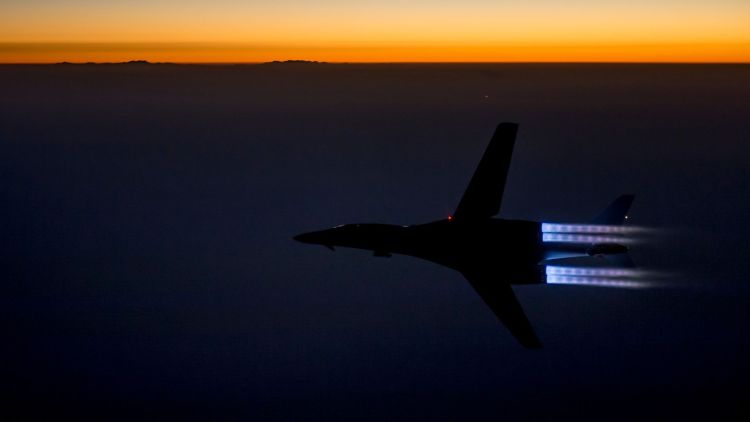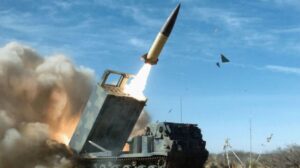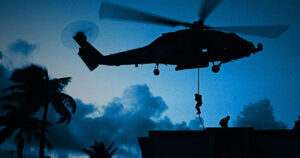Today’s Pic of the Day gives spotlights the ever-iconic, legendary—B-1B Lancer. Revered for its speed and power, you can see the supersonic bomber breaking away with afterburners glowing against the dusk after conducting airstrikes against ISIL (Islamic State of Iraq and the Levant) targets in Syria in 2014.
The Development and Rise of the B-1B Lancer
The B-1B Lancer, often affectionately called “The Bone” (derived from “B-One“), traces its origins to the 1970s as a supersonic heavy bomber designed to replace the aging B-52 Stratofortress.
“The Bone” was originally intended to operate at both low and high altitudes, offering a versatile platform for both nuclear and conventional missions.
However, its development path was anything but straightforward.
The initial model, the B-1A, was introduced in the early 1970s under President Richard Nixon. But, in 1977, President Jimmy Carter canceled the project, citing high costs and strategic issues during the Cold War.
Rockwell B-1A prototype (Wikimedia Commons)
Then, when President Ronald Reagan took office in 1981, he revitalized the program, leading to the development of the B-1B Lancer.
The B-1B was faster, stealthier, and more capable of low-level penetration than its predecessor, thanks to extensive modifications, including reduced radar cross-section, improved avionics, and enhanced durability.
The B-1B entered service in 1986, specifically designed for strategic bombing missions.
Today’s Pic of the Day gives spotlights the ever-iconic, legendary—B-1B Lancer. Revered for its speed and power, you can see the supersonic bomber breaking away with afterburners glowing against the dusk after conducting airstrikes against ISIL (Islamic State of Iraq and the Levant) targets in Syria in 2014.
The Development and Rise of the B-1B Lancer
The B-1B Lancer, often affectionately called “The Bone” (derived from “B-One“), traces its origins to the 1970s as a supersonic heavy bomber designed to replace the aging B-52 Stratofortress.
“The Bone” was originally intended to operate at both low and high altitudes, offering a versatile platform for both nuclear and conventional missions.
However, its development path was anything but straightforward.
The initial model, the B-1A, was introduced in the early 1970s under President Richard Nixon. But, in 1977, President Jimmy Carter canceled the project, citing high costs and strategic issues during the Cold War.
Rockwell B-1A prototype (Wikimedia Commons)
Then, when President Ronald Reagan took office in 1981, he revitalized the program, leading to the development of the B-1B Lancer.
The B-1B was faster, stealthier, and more capable of low-level penetration than its predecessor, thanks to extensive modifications, including reduced radar cross-section, improved avionics, and enhanced durability.
The B-1B entered service in 1986, specifically designed for strategic bombing missions.
However, in the 1990s, the bomber was adapted to carry conventional munitions following the START I treaty, which significantly limited its nuclear capabilities.
The versatility of the B-1B Lancer quickly became apparent, and it would soon prove itself in modern combat operations.
Technical Specifications and Power
The B-1B Lancer is an impressive machine by any standard.
With its swing-wing design, the Lancer can adjust its wing configuration mid-flight, allowing it to either maximize speed or increase fuel efficiency and stability during long-range missions. This flexibility has given it a crucial role in both strategic and tactical operations.
Max Speed: The B-1B can reach Mach 1.25 (950 mph) at high altitudes, making it the fastest bomber in the US Air Force’s fleet.
Range: With a range of over 7,000 miles, the Lancer is capable of long-range, intercontinental missions without refueling.
Payload: The B-1B can carry a staggering 75,000 pounds of munitions—making it the largest payload capacity of any Air Force bomber. This includes a wide array of conventional bombs, precision-guided munitions, and air-to-ground missiles.
Engines: Powered by four General Electric F101-GE-102 turbofan engines, each delivering 30,000 pounds of thrust, the Lancer’s afterburners offer it tremendous power and speed.
With these capabilities, the B-1B became a staple in modern warfare, particularly in Operation Enduring Freedom in Afghanistan and the War on Terror.
The Role of the B-1B in the Fight Against ISIL
Fast forward to 2014, and the B-1B Lancer was once again called upon for a critical mission. In response to the rapid expansion of ISIL across Iraq and Syria, the US military initiated Operation Inherent Resolve—a concerted effort to degrade and destroy the extremist group’s capabilities through airstrikes and ground operations.
The airstrikes conducted by the B-1B Lancer between August 2014 and January 2015 were part of a broader strategy aimed at disrupting ISIL’s ability to command and control its forces.
The strikes targeted ISIL strongholds, military assets, training camps, and key supply routes.
The B-1 B’s ability to carry large payloads of precision-guided bombs, such as the Joint Direct Attack Munition (JDAM), allowed it to strike with incredible accuracy while minimizing collateral damage.
The choice of the B-1B Lancer for these missions was strategic. Its long-range capability meant it could fly from distant bases, strike targets deep within enemy territory and return without refueling, making it a critical asset in the fight against an enemy entrenched in urban environments and difficult-to-reach areas.
Its ability to deliver precision strikes from high altitudes also gave the coalition forces a significant advantage in minimizing risks to civilians while effectively neutralizing ISIL’s leadership and infrastructure.
During the strikes, the B-1B really showed what it’s made of with its speed, heavy payload, and pinpoint accuracy.
By flying over Syria and hitting ISIL’s command centers hard, the bomber helped clear the path for ground troops and coalition partners to take back key areas that had fallen under ISIL’s control. It was a crucial piece in turning the tide against extremists.
The Image: A Moment of Strength and Precision
The image of the B-1B Lancer breaking away with afterburners glowing vividly in the aftermath of those strikes in 2014 is more than just a photograph of military hardware in action.
It represents a turning point in the war against ISIL—a moment where the US Air Force demonstrated the full might of its precision-strike capabilities.
That same image also serves as a reminder of the technological advancements in modern warfare.
The B-1B Lancer, once designed for strategic nuclear missions, has evolved into a critical player in conventional wars—capable of surgical strikes that can cripple an enemy’s infrastructure with precision.
B-1B Lancer flies over northern Iraq, September 27, 2014. (DVIDS)
The Ongoing Role of the B-1B
Even today, the B-1B Lancer plays a crucial role in the US Air Force’s operations, taking part in global missions that help deter threats and strike key targets.
There’s plenty of talk about what the future holds for the Lancer—especially with newer bombers like the B-21 Raider in the works—but there’s no question that the B-1B has cemented its place as one of the most versatile and powerful bombers in American history.
As it showed during the Syria strikes, the B-1 B’s mix of speed, range, payload, and precision makes it a go-to option for modern warfare.
Those airstrikes against ISIL were just one chapter in its long career, proving that the Lancer can adapt to changing battlefields and remain a key asset for the US and its allies.
Wrapping It Up: Why the B-1B Still Dominates
The B-1B Lancer’s strike on ISIL targets in Syria a decade ago was a solid reminder of the U.S. military’s impressive precision airpower and its ability to reach far-flung targets when it counts.
Originally designed as a nuclear deterrent during the Cold War, the B-1B has evolved into a frontline bomber, taking on some of today’s toughest missions.
Time and again, it’s proven its worth in the fight against extremism and beyond.
As global challenges shift, the B-1B Lancer continues to show just how adaptable and strong American military technology can be. Whether it’s streaking through the sky with afterburners lit or delivering pinpoint strikes, the B-1B remains a symbol of American air dominance and its ability to project power across the globe.
—
Disclaimer: SOFREP utilizes AI for image generation and article research. Occasionally, it’s like handing a chimpanzee the keys to your liquor cabinet. It’s not always perfect and if a mistake is made, we own up to it full stop. In a world where information comes at us in tidal waves, it is an important tool that helps us sift through the brass for live rounds.



